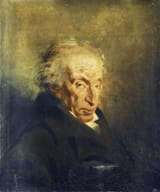Search Results
7/8/2025, 11:39:15 PM
>>509865626
>Filippo Giuseppe Maria Ludovico Buonarroti (1761, called the Father of Revolutionary Socialism) - It appears that he was a Freemason, possibly affiliated to the Illuminati of Bavaria. In 1793, Buonarroti was rewarded for his long revolutionary services by a special decree of nationalization as a French citizen. In 1795, Buonarroti was imprisoned at Paris where he met “Gracchus” Babeuf. Babeuf was the author of the “Manifesto of the Equals”, the so-called first Communist Manifesto. It is alleged that Buonarroti was its co-author. Their manifesto called for the restoration of the unimplemented Constitution of 1793. Buonarroti was an advocate of conspiratorial techniques, which were needed to fight the government. In 1796, Babeuf was executed and Buonarroti was, once again, imprisoned in 1797.
>In 1828, Philippe Buonarroti would publish the classic “Histoire de la Conspiration de l'egalite” (on Babeuf and conspiracy). As stated in the previous paragraph, around 1804 Buonarroti started to make plans for the formation of a “Italian Secret Society with revolutionary intentions”. It is said that in the following years Buonarroti organized, under the cover of Freemasonry, a network of Secret Societies all over France and Italy. Buonarroti was a Babeufist. He favoured the idea of a unification of France and Italy. He envisioned a State which unified the ideas of the democratic revolution of Robespierre and the social revolution of Babeuf. Buonarroti’s vision of Freemasonry unified the “ancienne Maconnerie des Lumieres”, the basic principles of ancient Freemasonry (of Light), and the Carbonari of which he was one of its creators and secret heads. “Seemingly, he organized a Philadelphe group within a Masonic lodge to which he belonged, the Amis Sinceres
>Filippo Giuseppe Maria Ludovico Buonarroti (1761, called the Father of Revolutionary Socialism) - It appears that he was a Freemason, possibly affiliated to the Illuminati of Bavaria. In 1793, Buonarroti was rewarded for his long revolutionary services by a special decree of nationalization as a French citizen. In 1795, Buonarroti was imprisoned at Paris where he met “Gracchus” Babeuf. Babeuf was the author of the “Manifesto of the Equals”, the so-called first Communist Manifesto. It is alleged that Buonarroti was its co-author. Their manifesto called for the restoration of the unimplemented Constitution of 1793. Buonarroti was an advocate of conspiratorial techniques, which were needed to fight the government. In 1796, Babeuf was executed and Buonarroti was, once again, imprisoned in 1797.
>In 1828, Philippe Buonarroti would publish the classic “Histoire de la Conspiration de l'egalite” (on Babeuf and conspiracy). As stated in the previous paragraph, around 1804 Buonarroti started to make plans for the formation of a “Italian Secret Society with revolutionary intentions”. It is said that in the following years Buonarroti organized, under the cover of Freemasonry, a network of Secret Societies all over France and Italy. Buonarroti was a Babeufist. He favoured the idea of a unification of France and Italy. He envisioned a State which unified the ideas of the democratic revolution of Robespierre and the social revolution of Babeuf. Buonarroti’s vision of Freemasonry unified the “ancienne Maconnerie des Lumieres”, the basic principles of ancient Freemasonry (of Light), and the Carbonari of which he was one of its creators and secret heads. “Seemingly, he organized a Philadelphe group within a Masonic lodge to which he belonged, the Amis Sinceres
Page 1
